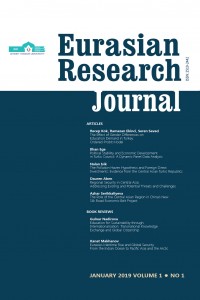Research Article
Year 2019,
Volume: 1 Issue: 1, 9 - 17, 15.01.2019
Abstract
References
- Dayioglu, Meltem, Murat G. Kidar and Aysit Tansel (2009). “Impact of Sibship Size, Birth Order and Sex Composition on School Enrolment in Urban Turkey”. Oxford Bulletin of Economics and Statistics 71(3): 399-426. Greene, William H. (2002). Econometric Analysis. Upper Saddle River, New Jersey, United States: Prentice Hall, 5th Edition. Kilic, Dilek (2012). Empirical Analysis of Health and Educational Attainment in Turkey. Doctoral Thesis, Sheffield, UK, University of Sheffield for the Degree of Doctor of Philosophy in the Department of Economics. King, Elizabeth M. and Lee A. Lillard (1983). Determinants of Schooling Attainment and Enrolment Rates in the Philippines. RAND Santa Monica, CA 90406. Rankin, Bruce H. and Isik A. Aytac, (2006). “Gender Inequality in Schooling: The Case of Turkey”. Sociology of Education 79(1): 25-43. Smits, Jeroen and Ayse G. Hosgor, (2006). “Effects of Family Background Characteristics on Educational Participation in Turkey”. International Journal of Educational Development 26(5): 545-560. Tansel, Aysit (2002). “Determinants of School Attainment of Boys and Girls in Turkey: Individual, Household and Community Factors”. Economics of Education Review 21(5): 455-470. Tansel, Aysit (1997). “Schooling Attainment, Parental Education and Genderin Cote d’Ivoire and Ghana”. Economic Development and Cultural Change 45(4): 825-856.
Year 2019,
Volume: 1 Issue: 1, 9 - 17, 15.01.2019
Abstract
The aim of the paper is to analyze the factors that affect education demand with regard to gender differences and determine main determinants of education demand. In this study, beyond the relation between education and welfare, by showing the effect of demographic and socio-psychological characteristics of the households on education demand, it is expected to contribute to the development of education policy. The data is taken from Turkish Statistical Institute’s Household Budget Survey for 2014 and policy recommendations are developed by comparing the results of ordered probit model with marginal effects with the findings in literature.
References
- Dayioglu, Meltem, Murat G. Kidar and Aysit Tansel (2009). “Impact of Sibship Size, Birth Order and Sex Composition on School Enrolment in Urban Turkey”. Oxford Bulletin of Economics and Statistics 71(3): 399-426. Greene, William H. (2002). Econometric Analysis. Upper Saddle River, New Jersey, United States: Prentice Hall, 5th Edition. Kilic, Dilek (2012). Empirical Analysis of Health and Educational Attainment in Turkey. Doctoral Thesis, Sheffield, UK, University of Sheffield for the Degree of Doctor of Philosophy in the Department of Economics. King, Elizabeth M. and Lee A. Lillard (1983). Determinants of Schooling Attainment and Enrolment Rates in the Philippines. RAND Santa Monica, CA 90406. Rankin, Bruce H. and Isik A. Aytac, (2006). “Gender Inequality in Schooling: The Case of Turkey”. Sociology of Education 79(1): 25-43. Smits, Jeroen and Ayse G. Hosgor, (2006). “Effects of Family Background Characteristics on Educational Participation in Turkey”. International Journal of Educational Development 26(5): 545-560. Tansel, Aysit (2002). “Determinants of School Attainment of Boys and Girls in Turkey: Individual, Household and Community Factors”. Economics of Education Review 21(5): 455-470. Tansel, Aysit (1997). “Schooling Attainment, Parental Education and Genderin Cote d’Ivoire and Ghana”. Economic Development and Cultural Change 45(4): 825-856.
There are 1 citations in total.
Details
| Primary Language | English |
|---|---|
| Journal Section | Book Reviews |
| Authors | |
| Publication Date | January 15, 2019 |
| Published in Issue | Year 2019 Volume: 1 Issue: 1 |

